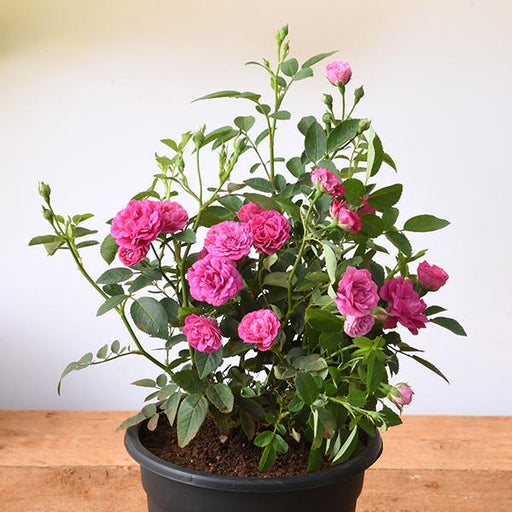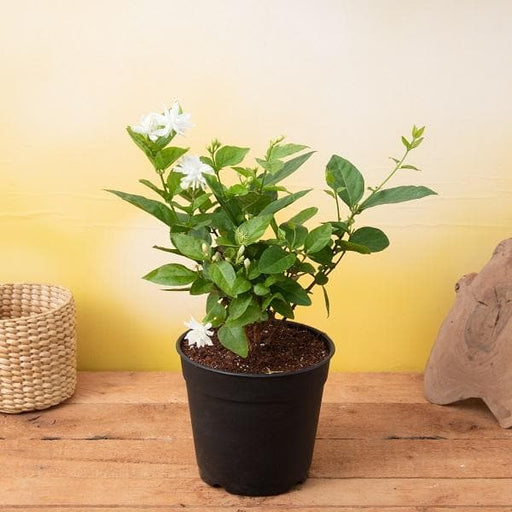
Caesalpinia pulcherima cremica - Plant
(MRP Inclusive of all taxes)
- Shipping ₹79 for entire order
- Dispatch in 7 days
- Country of origin: India

(MRP Inclusive of all taxes)
 Save 29%
Save 29%
Air Purifier Money Plant with Pot The Air Purifier Money Plant, also known as Pothos or Epipremnum aureum, is a stunning indoor plant that...
View full details
 Save up to 15%
Save up to 15%
Peace Lily, Spathiphyllum - Plant The Peace Lily, scientifically known as Spathiphyllum, is a stunning houseplant celebrated for its elegant white...
View full details
 Save 25%
Save 25%
Jasminum sambac, Mogra, Arabian Jasmine - Plant Jasminum sambac, commonly known as Mogra or Arabian Jasmine, is a fragrant flowering plant...
View full details
 Save 18%
Save 18%
Combo Constituents Includes the Parijat Tree (Night-Flowering Jasmine), a culturally significant plant with fragrant flowers. Description The Pari...
View full details
 Save 25%
Save 25%
Miniature Rose, Button Rose (Any Color) - Plant The Miniature Rose, also known as the Button Rose, is a charming and compact flowering plant that ...
View full details Save 25%
Save 25%
Damascus Rose, Scented Rose (Any Color) - Plant The Damascus Rose, also known as Rosa damascena, is a timeless symbol of beauty and romanc...
View full details
 Save 17%
Save 17%
Beautiful Fragrant Mogra, Arabian Jasmine Plant with Pot The Beautiful Fragrant Mogra, also known as Arabian Jasmine (Jasminum sambac), is...
View full details Save 15%
Save 15%
Pack of Vermicompost and Neem Cake for House Plants Transform your indoor garden with our premium Pack of Vermicompost and Neem Cake, spec...
View full details
Pack of Plant Growth and Flower Boosters Unlock the full potential of your garden with our Pack of Plant Growth and Flower Boosters! This ...
View full details Save 38%
Save 38%
Combo of Jeevamrut and Neem Raksha for Easy Growth and Protection of Houseplants Transform your indoor garden with our exclusive combo of ...
View full details Save 22%
Save 22%
Plant Nutrients Kit (Pack of 16) for a Healthy Garden Transform your garden into a lush paradise with our Plant Nutrients Kit, featuring 1...
View full details Save 16%
Save 16%
Combo of Top Plant Fertilizers Elevate your gardening game with our exclusive Combo of Top Plant Fertilizers, featuring two bags of premiu...
View full details Save 24%
Save 24%
Pack of 4 Additives to Make Soil Healthy and Nutrient Rich Transform your garden into a thriving ecosystem with our Pack of 4 Additives de...
View full details Save 30%
Save 30%
Transform your gardening experience with our premium Combo of Perlite and Vermiculite. This unique blend is designed to enhance soil aeration and ...
View full details Save 27%
Save 27%
Combo of 2 Vermicompost and Cocopeat - Enrich Your Soil Naturally! Transform your garden into a thriving ecosystem with our Combo of 2 Ver...
View full details
 Save 35%
Save 35%
Best 6 Plants for Perfect Indoor Garden Transform your living space into a lush oasis with our curated collection of the Best 6 Plants for a...
View full details
 Save up to 50%
Save up to 50%
Mini Succulent Garden Pack Transform your space with our Mini Succulent Garden Pack, featuring a delightful collection of 4 any variety beautiful s...
View full details
 Save 30%
Save 30%
5 Best Fragrant Plants Transform your garden or indoor space into a fragrant paradise with our curated selection of the 5 Best Fragrant Plants. Th...
View full details
 Save 24%
Save 24%
Set of 2 Bonsai Looking Grafted Adeniums Transform your indoor or outdoor space with our exquisite Set of 2 Bonsai Looking Grafted Adenium...
View full details Save 45%
Save 45%
Top 4 Die Hard Succulents Pack Transform your indoor or outdoor space with our Top 4 Die Hard Succulents Pack, featuring a curated selecti...
View full details
 Save 30%
Save 30%
5 Best Indoor Plants Pack Transform your living space into a lush oasis with our '5 Best Indoor Plants Pack.' This carefully curated collection fe...
View full details
 Save 25%
Save 25%
Set of 4 Evergreen Air Purifier Plant Pack Transform your indoor space into a lush, green oasis with our Set of 4 Evergreen Air Purifier Pla...
View full details| SrNo | Item Name |
|---|---|
| 1 | Caesalpinia pulcherima cremica - Plant |
Caesalpinia pulcherima 'Cremica', commonly known as the Pride of Barbados, is a stunning tropical plant renowned for its vibrant, flame-like flowers. This perennial shrub can reach heights of up to 10 feet and is characterized by its feathery, fern-like foliage. The 'Cremica' variety showcases bright orange and yellow blooms that attract pollinators, making it a favorite among gardeners and nature enthusiasts alike.
What makes the 'Cremica' variety special is its ability to thrive in various soil types and its resilience to drought conditions. This plant not only adds a splash of color to gardens but also plays a vital role in supporting local ecosystems by providing nectar for bees and butterflies. Its striking appearance and ecological benefits make it a must-have for any garden.
One of the standout features of Caesalpinia pulcherima 'Cremica' is its long blooming season, which can last from spring through fall. The flowers are not only visually appealing but also have a pleasant fragrance, enhancing the sensory experience of any outdoor space. Additionally, this plant is known for its ability to improve soil quality, making it an excellent choice for sustainable gardening.
Caesalpinia pulcherima 'Cremica' contributes positively to the environment by improving soil quality and providing habitat for various pollinators. Its ability to thrive in poor soil conditions makes it an excellent choice for reforestation and erosion control projects. By planting this species, gardeners can help promote biodiversity and support local ecosystems.
If you think caring for a plant is as easy as watering it and hoping for the best, think again! Caesalpinia pulcherima, also known as the flamboyant tree, requires a bit more finesse. This diva of the plant world loves well-drained soil and plenty of sunshine. So, if you’re planning to pamper it, make sure it gets at least six hours of sunlight daily. And don’t forget to prune it regularly; it’s like giving your plant a stylish haircut. With the right care, your flamboyant tree will reward you with vibrant flowers that scream, “Look at me!”
Who knew that planting a tree could come with a side of benefits? Caesalpinia pulcherima isn’t just a pretty face; it’s also a fantastic air purifier. This tree absorbs carbon dioxide and releases oxygen, making it a green superhero in your garden. Plus, its stunning flowers attract pollinators like bees and butterflies, turning your yard into a buzzing paradise. And let’s not forget the shade it provides—perfect for those lazy summer afternoons when you want to sip lemonade without turning into a human barbecue.
Ready to spread the love? Propagating Caesalpinia pulcherima is easier than convincing your friends to join you for brunch. You can start with seeds or cuttings, but seeds are the rock stars of propagation. Soak them overnight to soften their tough exterior, then plant them in well-draining soil. Keep them warm and moist, and soon you’ll have little seedlings sprouting like they’re auditioning for a role in a nature documentary. Just remember, patience is key—good things come to those who wait!
If you’re looking for a tree that grows faster than your neighbor’s gossip, look no further! Caesalpinia pulcherima boasts a growth rate that can leave you in awe. Under ideal conditions, it can reach heights of up to 30 feet in just a few years. That’s right; it’s the overachiever of the plant kingdom! Just make sure it has enough space to spread its roots and branches, or it might start feeling a bit claustrophobic.
This tree isn’t just a pretty face; it’s a multi-talented superstar! Caesalpinia pulcherima can be used for landscaping, erosion control, and even as a natural privacy screen. Its vibrant flowers can brighten up any dull garden, while its dense foliage provides a cozy hideaway for birds and other critters. Plus, it’s drought-tolerant, making it the perfect choice for those who want a low-maintenance garden that still looks fabulous.
Every diva has her haters, and Caesalpinia pulcherima is no exception. While this tree is generally resilient, it can attract a few pesky pests like aphids and spider mites. But fear not! A little neem oil or insecticidal soap can send those unwanted guests packing. Just remember to keep an eye on your tree; after all, you wouldn’t want it to throw a tantrum over a few bugs, would you?
If you want your Caesalpinia pulcherima to thrive, you better roll out the red carpet for its soil! This tree prefers well-draining soil that’s rich in organic matter. Think of it as a high-maintenance celebrity that won’t settle for anything less than the best. Avoid heavy clay or overly wet conditions, as they can lead to root rot—definitely not the kind of drama you want in your garden.
Sunlight is the secret sauce for a happy Caesalpinia pulcherima. This tree is a sun worshipper, craving at least six hours of direct sunlight each day. If you try to plant it in the shade, it might just sulk and refuse to bloom. So, find a sunny spot in your garden, and watch as it transforms into a vibrant spectacle of color.
Get ready for a floral fiesta! Caesalpinia pulcherima typically bursts into bloom during the warmer months, showcasing its stunning red, orange, or yellow flowers. It’s like a party in your garden, and everyone’s invited! The flowering season can vary depending on the climate, but when it happens, you’ll want to grab your camera because this tree knows how to steal the show.
If you want your Caesalpinia pulcherima to thrive, you better check the weather forecast! This tree loves warm, tropical climates and can’t stand frost. It’s like that friend who only wants to hang out at the beach—no winter wonderland for them! If you live in a cooler area, consider planting it in a pot so you can bring it indoors during the chilly months.
Looking to add a splash of color to your garden? Caesalpinia pulcherima is your go-to plant! Use it as a focal point in your landscape design, or plant it in clusters for a dramatic effect. Its vibrant flowers and lush foliage can complement any garden style, from tropical to modern. Just remember to give it enough space to shine, and your garden will be the talk of the town!
Caesalpinia pulcherima cremica, also known as the flamboyant tree, is a tropical beauty that flaunts vibrant orange-red flowers. It’s like nature’s own fireworks display! This plant thrives in warm climates and can grow up to 30 feet tall, making it a showstopper in any garden. Just don’t forget to water it; even flamboyants need a drink!
Caring for this diva is easy! Plant it in well-drained soil and give it full sun to shine. Water it regularly, but don’t drown it—this isn’t a swimming competition! Prune it to maintain shape and encourage blooming. With a little love, your flamboyant tree will reward you with a stunning floral display that’ll make your neighbors green with envy.
This plant loves to bask in the sun, so aim for at least six hours of direct sunlight daily. It prefers warm temperatures and well-drained soil. Think of it as a sunbather on a tropical vacation—too much shade or soggy soil will have it sulking. Keep it cozy, and it’ll thrive like a beach bum!
While it dreams of outdoor glory, you can grow it indoors if you have a sunny spot. Just remember, it’s a tall drink of water, so choose a spacious area. Ensure it gets plenty of light and keep the humidity up. If it starts to look droopy, it might be longing for the great outdoors!
Watering is a balancing act! During the growing season, give it a good soak once a week, but let the soil dry out between drinks. In winter, cut back on watering—this plant likes to hibernate. Overwatering is a no-no; it’s not a fan of soggy feet, so keep it dry and happy!
Keep an eye out for pesky aphids and spider mites; they love to crash the party! If you spot them, a gentle spray of water or insecticidal soap will send them packing. Regularly check the leaves for any unwanted guests, and your flamboyant tree will continue to shine without any drama!
Good news for pet lovers! Caesalpinia pulcherima cremica is generally considered non-toxic to cats and dogs. However, it’s always wise to keep an eye on your furry friends, as they might munch on anything that looks tasty. If they start acting funny after a snack, a trip to the vet might be in order!
This show-off typically blooms in late spring to summer, putting on a floral spectacle that’ll make you want to throw a garden party! The vibrant flowers attract pollinators, so expect a buzzing crowd. Just be patient; good things come to those who wait, and this plant knows how to make an entrance!
Absolutely! You can propagate this beauty through seeds or cuttings. For seeds, soak them overnight before planting to speed things up. If you’re going the cutting route, take a healthy stem and let it root in water or soil. With a little patience, you’ll have new flamboyant friends to brighten your garden!
This plant is a fast grower, often reaching its full height in just a few years. With the right conditions, you might find it adding several feet to its stature annually. It’s like the overachiever of the plant world—just make sure it has enough space to stretch its limbs and show off!
Yes, this plant is quite the survivor! Once established, it can tolerate short periods of drought, thanks to its deep roots. However, don’t push its limits; it still appreciates a good drink during dry spells. Think of it as a plant that enjoys a spa day but can handle a little roughing it!
Beyond its stunning beauty, this plant is often used for landscaping, providing shade, and attracting pollinators. Its wood can be used for crafts, and the flowers are sometimes used in traditional medicine. So, whether you want a garden showstopper or a crafty project, this plant has got you covered!